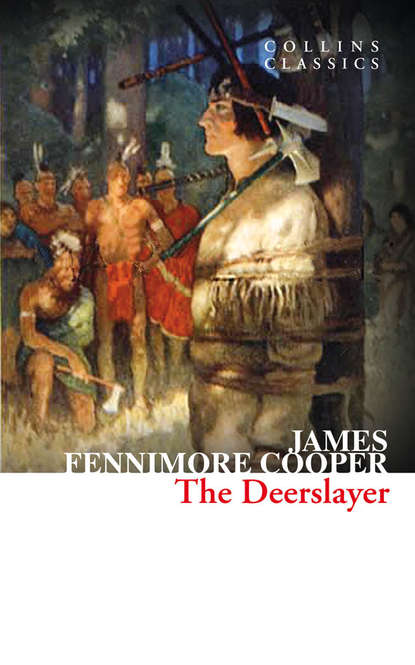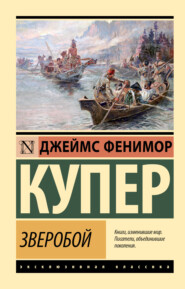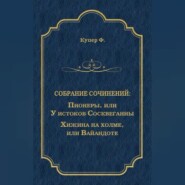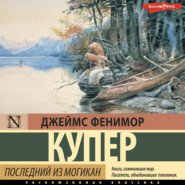По всем вопросам обращайтесь на: info@litportal.ru
(©) 2003-2024.
✖
The Deerslayer
Автор
Год написания книги
2019
Настройки чтения
Размер шрифта
Высота строк
Поля
The Deerslayer
James Fenimore Cooper
HarperCollins is proud to present its incredible range of best-loved, essential classics.Set in the 1740s, just after the start of the French and Indian wars, James Fenimore Cooper’s The Deerslayer tells the story of a young Natty Bumppo, most famously known as ‘Hawkeye’, and his Mohican ‘brother’ Chingachgook, as they attempt to rescue Chingachgook’s betrothed, Wah-ta-Wah, from the Hurons. When Bumppo’s friends Harry March and Tom Hutter are also captured, Bumppo must go on his first warpath in order to rescue them.Cooper’s final addition to his classic Leatherstocking series is one of the earliest novels to be considered truly ‘American’, due in no small part to the novel’s protagonist, who embodied the popular American ideals of individualism and liberty. The novel is a worthy prequel to the popular The Last of the Mohicans, full of adventure, suspense and romance.
THE DEERSLAYER
James Fenimore Cooper
Table of Contents
Title Page (#u62033274-256f-5709-9cc1-23e5b6c085fb)
History of Collins (#u695352be-8d68-556c-b121-23850a4198f0)
Life & Times (#u37c3b6de-a8f0-5a3d-9661-26932a7c4fb5)
Chapter 1 (#u979b4274-1c66-5eeb-b945-796c4ba84d08)
Chapter 2 (#u0d39de52-e035-5f2e-86f0-7145c6aa8819)
Chapter 3 (#u29ccf9b8-340f-578e-8855-2d02e0d7ee31)
Chapter 4 (#u67a2bbac-9d9c-5661-831f-7658007d119a)
Chapter 5 (#u3d8772f7-2fc9-531d-b2eb-952276d44feb)
Chapter 6 (#u6b04e196-3cc1-5c0e-8dca-3d920564567e)
Chapter 7 (#u66eaa003-a0d2-5312-8416-a59a02ddbde1)
Chapter 8 (#u57547c77-70ae-575f-b3ef-159cffbc5dc3)
Chapter 9 (#u8759b374-c8e1-5c80-8acb-9d76344d4316)
Chapter 10 (#litres_trial_promo)
Chapter 11 (#litres_trial_promo)
Chapter 12 (#litres_trial_promo)
Chapter 13 (#litres_trial_promo)
Chapter 14 (#litres_trial_promo)
Chapter 15 (#litres_trial_promo)
Chapter 16 (#litres_trial_promo)
Chapter 17 (#litres_trial_promo)
Chapter 18 (#litres_trial_promo)
Chapter 19 (#litres_trial_promo)
Chapter 20 (#litres_trial_promo)
Chapter 21 (#litres_trial_promo)
Chapter 22 (#litres_trial_promo)
Chapter 23 (#litres_trial_promo)
Chapter 24 (#litres_trial_promo)
Chapter 25 (#litres_trial_promo)
Chapter 26 (#litres_trial_promo)
Chapter 27 (#litres_trial_promo)
Chapter 28 (#litres_trial_promo)
Chapter 29 (#litres_trial_promo)
Chapter 30 (#litres_trial_promo)
Chapter 31 (#litres_trial_promo)
Chapter 32 (#litres_trial_promo)
Classic Literature: Words and Phrases adapted from the Collins English Dictionary (#litres_trial_promo)
Copyright (#litres_trial_promo)
About the Publisher (#litres_trial_promo)
History of Collins (#ulink_4ca955e9-7b9c-5c78-bc17-a49b6a570b8a)
In 1819, millworker William Collins from Glasgow, Scotland, set up a company for printing and publishing pamphlets, sermons, hymn books and prayer books. That company was Collins and was to mark the birth of HarperCollins Publishers as we know it today. The long tradition of Collins dictionary publishing can be traced back to the first dictionary William published in 1824, Greek and English Lexicon. Indeed, from 1840 onwards, he began to produce illustrated dictionaries and even obtained a licence to print and publish the Bible.
Soon after, William published the first Collins novel, Ready Reckoner, however it was the time of the Long Depression, where harvests were poor, prices were high, potato crops had failed and violence was erupting in Europe. As a result, many factories across the country were forced to close down and William chose to retire in 1846, partly due to the hardships he was facing.
Aged 30, William’s son, William II took over the business. A keen humanitarian with a warm heart and a generous spirit, William II was truly ‘Victorian’ in his outlook. He introduced new, up-to-date steam presses and published affordable editions of Shakespeare’s works and The Pilgrim’s Progress, making them available to the masses for the first time. A new demand for educational books meant that success came with the publication of travel books, scientific books, encyclopaedias and dictionaries. This demand to be educated led to the later publication of atlases and Collins also held the monopoly on scripture writing at the time.
In the 1860s Collins began to expand and diversify and the idea of ‘books for the millions’ was developed. Affordable editions of classical literature were published and in 1903 Collins introduced 10 titles in their Collins Handy Illustrated Pocket Novels. These proved so popular that a few years later this had increased to an output of 50 volumes, selling nearly half a million in their year of publication. In the same year, The Everyman’s Library was also instituted, with the idea of publishing an affordable library of the most important classical works, biographies, religious and philosophical treatments, plays, poems, travel and adventure. This series eclipsed all competition at the time and the introduction of paperback books in the 1950s helped to open that market and marked a high point in the industry.
HarperCollins is and has always been a champion of the classics and the current Collins Classics series follows in this tradition – publishing classical literature that is affordable and available to all. Beautifully packaged, highly collectible and intended to be reread and enjoyed at every opportunity.
Life & Times (#ulink_162eeec7-d80f-5f00-8045-3bf9715425c4)
James Fenimore Cooper
HarperCollins is proud to present its incredible range of best-loved, essential classics.Set in the 1740s, just after the start of the French and Indian wars, James Fenimore Cooper’s The Deerslayer tells the story of a young Natty Bumppo, most famously known as ‘Hawkeye’, and his Mohican ‘brother’ Chingachgook, as they attempt to rescue Chingachgook’s betrothed, Wah-ta-Wah, from the Hurons. When Bumppo’s friends Harry March and Tom Hutter are also captured, Bumppo must go on his first warpath in order to rescue them.Cooper’s final addition to his classic Leatherstocking series is one of the earliest novels to be considered truly ‘American’, due in no small part to the novel’s protagonist, who embodied the popular American ideals of individualism and liberty. The novel is a worthy prequel to the popular The Last of the Mohicans, full of adventure, suspense and romance.
THE DEERSLAYER
James Fenimore Cooper
Table of Contents
Title Page (#u62033274-256f-5709-9cc1-23e5b6c085fb)
History of Collins (#u695352be-8d68-556c-b121-23850a4198f0)
Life & Times (#u37c3b6de-a8f0-5a3d-9661-26932a7c4fb5)
Chapter 1 (#u979b4274-1c66-5eeb-b945-796c4ba84d08)
Chapter 2 (#u0d39de52-e035-5f2e-86f0-7145c6aa8819)
Chapter 3 (#u29ccf9b8-340f-578e-8855-2d02e0d7ee31)
Chapter 4 (#u67a2bbac-9d9c-5661-831f-7658007d119a)
Chapter 5 (#u3d8772f7-2fc9-531d-b2eb-952276d44feb)
Chapter 6 (#u6b04e196-3cc1-5c0e-8dca-3d920564567e)
Chapter 7 (#u66eaa003-a0d2-5312-8416-a59a02ddbde1)
Chapter 8 (#u57547c77-70ae-575f-b3ef-159cffbc5dc3)
Chapter 9 (#u8759b374-c8e1-5c80-8acb-9d76344d4316)
Chapter 10 (#litres_trial_promo)
Chapter 11 (#litres_trial_promo)
Chapter 12 (#litres_trial_promo)
Chapter 13 (#litres_trial_promo)
Chapter 14 (#litres_trial_promo)
Chapter 15 (#litres_trial_promo)
Chapter 16 (#litres_trial_promo)
Chapter 17 (#litres_trial_promo)
Chapter 18 (#litres_trial_promo)
Chapter 19 (#litres_trial_promo)
Chapter 20 (#litres_trial_promo)
Chapter 21 (#litres_trial_promo)
Chapter 22 (#litres_trial_promo)
Chapter 23 (#litres_trial_promo)
Chapter 24 (#litres_trial_promo)
Chapter 25 (#litres_trial_promo)
Chapter 26 (#litres_trial_promo)
Chapter 27 (#litres_trial_promo)
Chapter 28 (#litres_trial_promo)
Chapter 29 (#litres_trial_promo)
Chapter 30 (#litres_trial_promo)
Chapter 31 (#litres_trial_promo)
Chapter 32 (#litres_trial_promo)
Classic Literature: Words and Phrases adapted from the Collins English Dictionary (#litres_trial_promo)
Copyright (#litres_trial_promo)
About the Publisher (#litres_trial_promo)
History of Collins (#ulink_4ca955e9-7b9c-5c78-bc17-a49b6a570b8a)
In 1819, millworker William Collins from Glasgow, Scotland, set up a company for printing and publishing pamphlets, sermons, hymn books and prayer books. That company was Collins and was to mark the birth of HarperCollins Publishers as we know it today. The long tradition of Collins dictionary publishing can be traced back to the first dictionary William published in 1824, Greek and English Lexicon. Indeed, from 1840 onwards, he began to produce illustrated dictionaries and even obtained a licence to print and publish the Bible.
Soon after, William published the first Collins novel, Ready Reckoner, however it was the time of the Long Depression, where harvests were poor, prices were high, potato crops had failed and violence was erupting in Europe. As a result, many factories across the country were forced to close down and William chose to retire in 1846, partly due to the hardships he was facing.
Aged 30, William’s son, William II took over the business. A keen humanitarian with a warm heart and a generous spirit, William II was truly ‘Victorian’ in his outlook. He introduced new, up-to-date steam presses and published affordable editions of Shakespeare’s works and The Pilgrim’s Progress, making them available to the masses for the first time. A new demand for educational books meant that success came with the publication of travel books, scientific books, encyclopaedias and dictionaries. This demand to be educated led to the later publication of atlases and Collins also held the monopoly on scripture writing at the time.
In the 1860s Collins began to expand and diversify and the idea of ‘books for the millions’ was developed. Affordable editions of classical literature were published and in 1903 Collins introduced 10 titles in their Collins Handy Illustrated Pocket Novels. These proved so popular that a few years later this had increased to an output of 50 volumes, selling nearly half a million in their year of publication. In the same year, The Everyman’s Library was also instituted, with the idea of publishing an affordable library of the most important classical works, biographies, religious and philosophical treatments, plays, poems, travel and adventure. This series eclipsed all competition at the time and the introduction of paperback books in the 1950s helped to open that market and marked a high point in the industry.
HarperCollins is and has always been a champion of the classics and the current Collins Classics series follows in this tradition – publishing classical literature that is affordable and available to all. Beautifully packaged, highly collectible and intended to be reread and enjoyed at every opportunity.
Life & Times (#ulink_162eeec7-d80f-5f00-8045-3bf9715425c4)

















